

e-mail :

This document continues the investigation of special categories (If / Then constants), and compares crystals with organisms.
Crystals and Organisms, Shape, Symmetry and Promorph.
Sequel to the investigation of some (intrinsic) shapes of two-dimensional crystals regarding their relationship to intrinsic point symmetry and promorph.
Parallelogram / Rhombus
We shall start with the Parallelogram
Let us then consider a fully developed two-dimensional crystal having a parallelogram as its intrinsic shape :
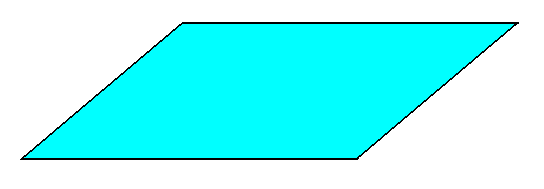
Any parallelogram can be conceived as being built up by a periodic stacking of microscopic parallelogrammatic units, as the next Figure illustrates.

The true (i.e. intrinsic) point symmetry of such a parallelogrammatic crystal is either according to the Cyclic Group C2 (crystallographically indicated as 2 ), or to the Asymmetric Group C1 (crystallographically indicated as 1 ), depending on the crystal's internal structure.
That an intrinsically parallelogrammatic crystal can have these intrinsic symmetries can be explained succinctly as follows (and will be further evident in the sequel) :
A Parallelogram as such has the following symmetries, i.e. it will be superposed upon itself by the following transformations (which are for that reason symmetry transformations) :

| Plane Group | Point Symmetry | Number of Forms |
| P1 | C1 ( 1 ) | 4 |
| P2 | C2 ( 2 ) | 2 |
The Parallelogram is supported by the following plane groups :
P2, which has a point symmetry according to C2 .
P1, which has a point symmetry according to C1 .
For each one of these plane groups we will show how it supports a parallelogrammatic crystal shape. The intrinsic shape of the crystal, in the present case its parallelogrammatic shape, depends on the Growth Rate Vector Rosette, which in turn depends on the atomic aspects (chemical nature of motifs and geometry of lattice) presented to the growing environment by the possible crystal faces. The parallelogrammatic crystal can be formed by the stacking of parallelogrammatic building blocks (unit meshes) containing a motif s.str. compatible with the point symmetry implied by the given plane group. The point symmetry is indicated in each case. Recall that the point symmetry of a crystal is the translation-free residue of its plane group symmetry.
A parallelogram, which has a symmetry according to the group C2 , will be supported by those plane groups of which all the implied point symmetries (i.e. implied by the plane group) are also symmetries of the Parallelogram. This does not necessarily hold the other way around : A crystal can have an intrinsic shape that is a parallelogram, but nevertheless some, or even all, symmetries of this parallelogram can be absent in the crystal, resulting in the fact that the intrinsic symmetry of the crystal is lower than that of its intrinsic shape.

Figure above : A parallelogrammatic two-dimensional C2 crystal supported by an oblique point lattice (indicated by connection lines).
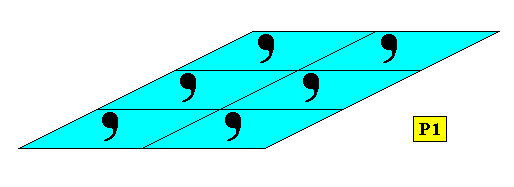
Figure above : A parallelogrammatic two-dimensional C1 crystal supported by an oblique point lattice (indicated by connection lines).
This concludes a summary, showing when, and in what way, parallelogrammatic two-dimensional crystals are supported. As can be seen in the above Figures the actual point symmetry of the (parallelogrammatic) crystal can be lower than that of the Parallelogram. So in the Figure just above, we see a crystal having the (intrinsic) shape of a parallelogram, which as such has C2 symmetry, wheras the crystal itself has a point symmetry according to the group C1 , because its parallelogrammatic meshes are provided with an asymmetric motif, destroying the crystal's symmetry, i.e. lowering its symmetry from C2 to C1 .
Now we shall deal with the
Rhombus
So let us consider a fully developed two-dimensional crystal having a rhombus as its intrinsic shape (a rhombus is a parallelogram with all sides of equal length) :
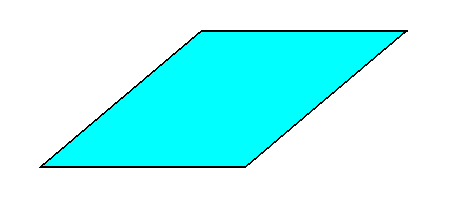
Any rhombus-shaped crystal can be conceived as being built up by a periodic stacking of microscopic rhombus-shaped units, as the next Figure illustrates.
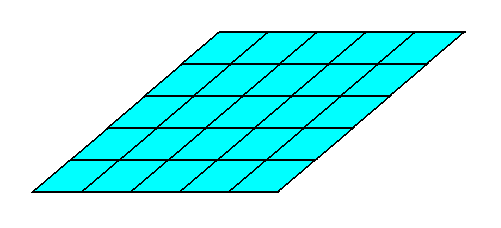
The true point symmetry of such an intrinsically rhombic crystal is either according to the Dihedral Group D2 (crystallographically denoted by 2mm ), or to the Dihedral Group D1 (crystallographically denoted by m ), or to the Cyclic Group C2 (crystallographically denoted by 2 ), or, finally, to the Asymmetric Group C1 , all depending on the crystal's internal structure.
That a rhombic crystal (i.e. a two-dimensional crystal having as its intrinsic shape the rhombus) can possess either of these symmetries can be explained succinctly as follows (and will be further evident in the sequel) :
A Rhombus as such has the following symmetries, i.e. it will be superposed upon itself by the following transformations (which are then for that reason symmetry transformations) :
The next table shows which plane groups can support rhombus-shaped (two-dimensional) crystals. It further indicates the corresponding point groups (with the crystallographic notation in brackets), and finally the number of crystallographic Forms needed in each case (i.e. each case of different point symmetry) to produce a rhombus :

| Plane Group | Point Symmetry | Number of Forms |
| P1 | C1 ( 1 ) | 4 |
| P2 | C2 ( 2 ) | 2 |
| Pm Cm Pg |
D1 ( m ) | 2 |
| P2mm C2mm P2mg P2gg |
D2 ( 2mm ) | 1 |
So the Rhombus is supported by the following plane groups :
P2mm, C2mm, P2mg, P2gg, which have a point symmetry according to D2 .
Pm, Cm, Pg, which have a point symmetry according to D1 .
P2, which has a point symmetry according to C2 .
P1, which has a point symmetry according to C1 (asymmetric group).
For each of these plane groups we will show how it supports a rhombic crystal shape. The intrinsic shape of the crystal, in the present case its rhombic shape, depends on the Growth Rate Vector Rosette, which in turn depends on the atomic aspects (chemical nature of motifs and geometry of lattice) presented to the growing environment by the possible crystal faces. The rhombic crystal can be formed by the stacking of rectangular or rhombic building blocks (unit meshes) containing a motif s.str. compatible with the point symmetry implied by the given plane group. The point symmetry is indicated in each case. Recall that the point symmetry of a crystal is the translation-free residue of its plane group symmetry.
A rhombus, which has a symmetry according to the group D2 , will be supported by those plane groups of which all the implied point symmetries (i.e. implied by the plane group) are also symmetries of the Rhombus. This does not necessarily hold the other way around : A crystal can have an intrinsic shape that is a rhombus, but nevertheless some, or even all, symmetries of this rhombus can be absent in the crystal, resulting in the fact that the intrinsic symmetry of the crystal is lower than that of its intrinsic shape.
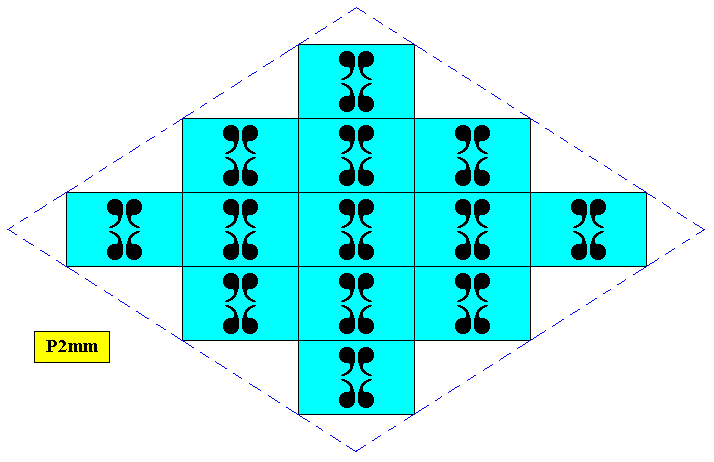
Figure above : A rhombus-shaped two-dimensional D2 crystal supported by a primitive rectangular point lattice (indicated by connection lines).
In order to have a better overview of such a crystal, we depict a somewhat different and smaller version of it :
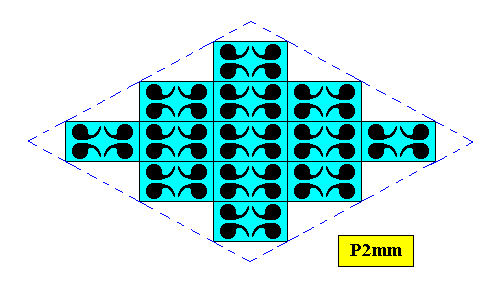
Figure above : A rhombus-shaped two-dimensional D2 crystal supported by a primitive rectangular point lattice (indicated by connection lines).
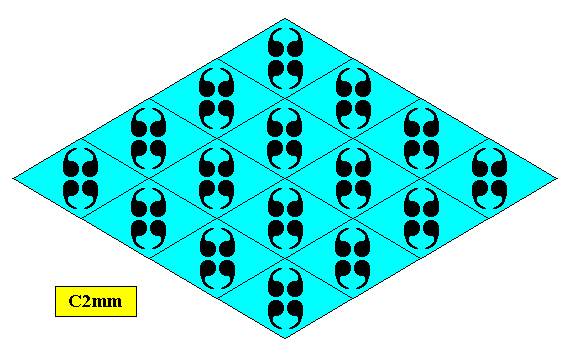
Figure above : A rhombus-shaped two-dimensional D2 crystal supported by a rhombic point lattice (indicated by connection lines).
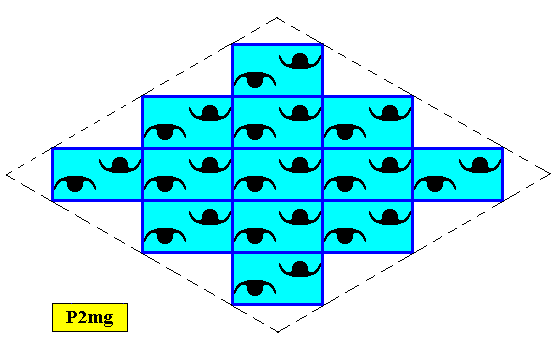
Figure above : A rhombus-shaped two-dimensional D2 crystal supported by a primitive rectangular point lattice (indicated by connection lines).
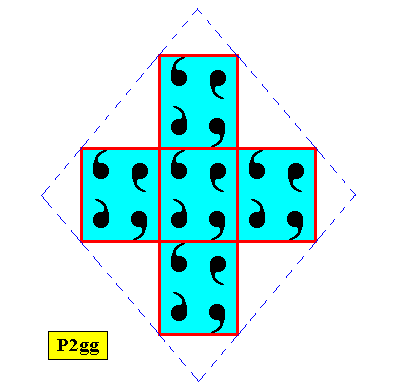
Figure above : A rhombus-shaped two-dimensional D2 crystal supported by a primitive rectangular point lattice (indicated by connection lines).

Figure above : A rhombus-shaped two-dimensional D1 crystal supported by a primitive rectangular point lattice (indicated by connection lines).
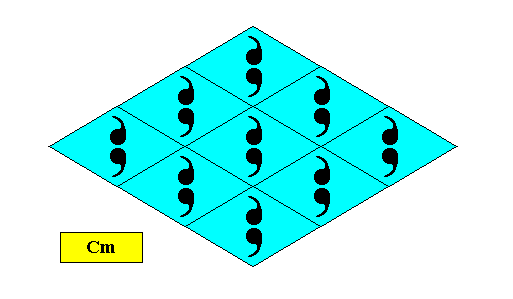
Figure above : A rhombus-shaped two-dimensional D1 crystal supported by a rhombic point lattice (indicated by connection lines).
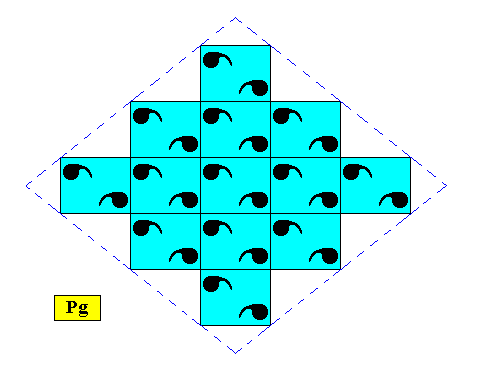
Figure above : A rhombus-shaped two-dimensional D1 crystal supported by a primitive rectangular point lattice (indicated by connection lines).
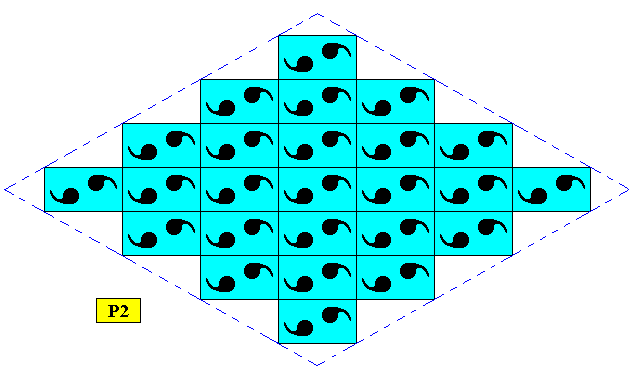
Figure above : A rhombus-shaped two-dimensional C2 crystal supported by an oblique point lattice (indicated by connection lines) where the angles happen to be 900.
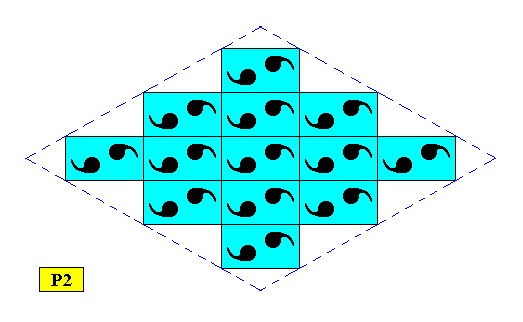
Figure above : Same as previous Figure, but smaller version : A rhombus-shaped two-dimensional C2 crystal supported by an oblique point lattice (indicated by connection lines) where the angles happen to be 900.
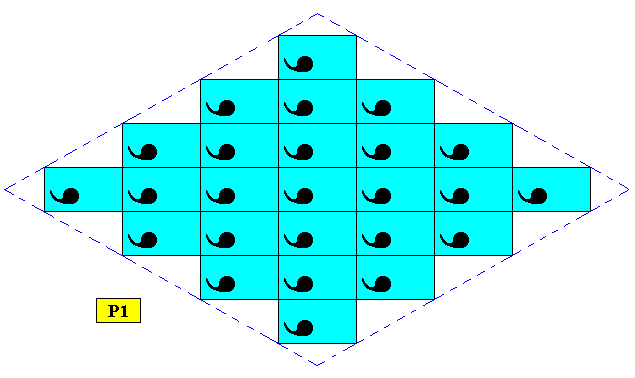
Figure above : A rhombus-shaped two-dimensional C1 crystal supported by an oblique point lattice (indicated by connection lines) where the angles happen to be 900.
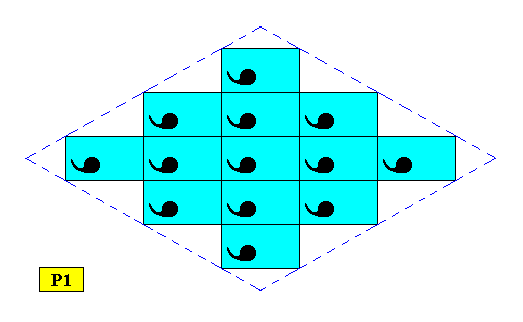
Figure above : Same as previous Figure, but smaller version : A rhombus-shaped two-dimensional C1 crystal supported by an oblique point lattice (indicated by connection lines) where the angles happen to be 900.
This concludes a summary, showing when, and in what way, rhombus-shaped two-dimensional crystals are supported. As can be seen in the above Figures, in many cases the actual point symmetry of the (rhombus-shaped) crystal is lower than that of the Rhombus.
In the next document we will investigate the promorphs of such crystals.
e-mail : 
To continue click HERE for further study of the Theory of Layers, Part X.
e-mail : 